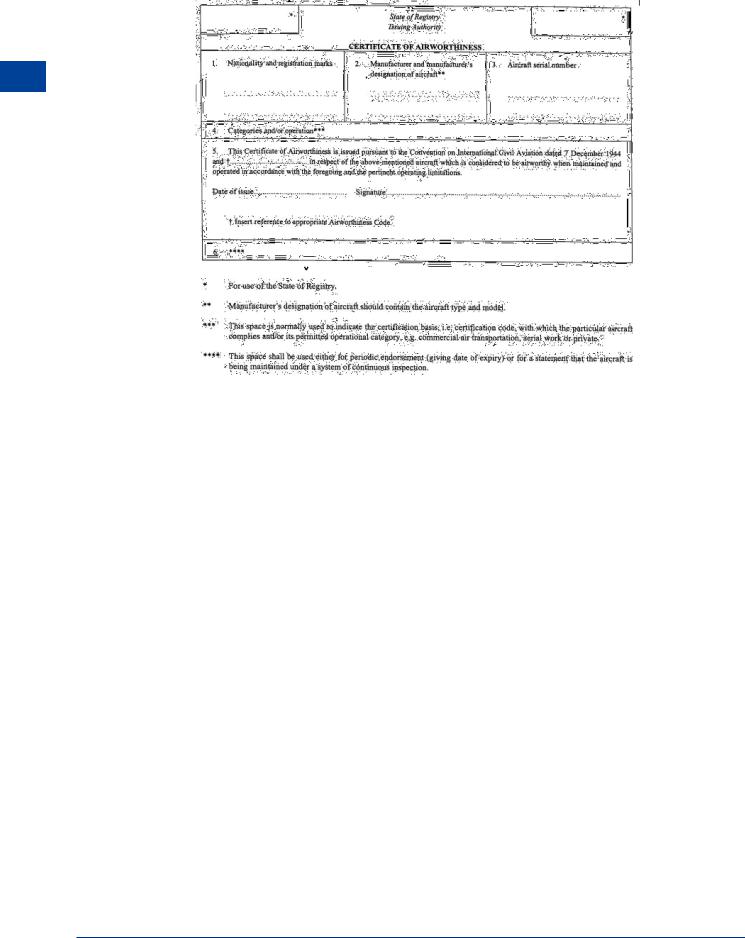
- •Textbook Series
- •Contents
- •1 Definitions
- •Introduction
- •Abbreviations
- •Definitions
- •2 International Agreements and Organizations
- •The Chicago Convention
- •International Law
- •Commercial Considerations
- •Customs and Excise, and Immigration
- •International Obligations of Contracted States
- •Duties of ICAO Member States
- •Status of Annex Components
- •The International Civil Aviation Organization (ICAO)
- •The Organization of ICAO
- •Regional Structure of ICAO
- •Regional Structure and Offices
- •ICAO Publications
- •Other International Agreements
- •The Conventions of Tokyo, the Hague and Montreal
- •The Warsaw Convention
- •The Rome Convention
- •IATA
- •ECAC
- •EASA
- •Eurocontrol
- •World Trade Organization
- •Geneva Convention
- •EU Regulation 261/2004
- •Questions
- •Answers
- •3 Airworthiness of Aircraft
- •Introduction
- •Airworthiness
- •Questions
- •Answers
- •4 Aircraft Nationality and Registration Marks
- •Introduction
- •Nationality and Registration Marks
- •Certification of Registration
- •Aircraft Markings
- •Classification of Aircraft
- •Questions
- •Answers
- •5 Flight Crew Licensing
- •Introduction
- •Definitions
- •General Rules Concerning Licensing
- •Licences and Ratings for Pilots
- •Multi-crew Pilot Licence (MPL)
- •Instrument Rating (Aeroplane) (IR(A))
- •Instructor and Examiner Rating
- •JAR-FCL 3 Medical Requirements
- •Pilot Proficiency
- •EASA Theoretical Knowledge Examinations
- •Questions
- •Answers
- •6 Rules of the Air
- •History
- •Applicability of the Rules of the Air
- •General Rules
- •Visual Flight Rules
- •Instrument Flight Rules
- •Semi-circular Flight Level Rules and RVSM
- •Special VFR
- •Distress and Urgency Signals
- •Restricted, Prohibited or Danger Areas
- •Signals for Aerodrome Traffic
- •Marshalling Signals
- •Flight Deck Signals
- •Questions
- •Answers
- •Instrument Procedures
- •PANS OPS
- •Instrument Departure Procedures
- •Questions
- •Answers
- •8 Approach Procedures
- •Procedure Basics
- •Approach Procedure Design
- •Obstacle Clearance Altitude/Height
- •Operating Minima
- •Descent Gradients
- •Track Reversal and Racetracks
- •Missed Approach Segment and Procedure
- •Published Information
- •RNAV Approach Procedures based on VOR/DME
- •Questions
- •Answers
- •9 Circling Approach
- •Circling Approach
- •Questions
- •Answers
- •10 Holding Procedures
- •Holding Procedures
- •Entry Sectors
- •ATC Considerations
- •Obstacle Clearance
- •Questions
- •Answers
- •11 Altimeter Setting Procedure
- •Altimeter Setting Objectives
- •Transition
- •Phases of Flight
- •Questions
- •Answers
- •12 Parallel or Near-parallel Runway Operation
- •Safety
- •Runway Spacing
- •Questions
- •Answers
- •13 SSR and ACAS
- •Airborne Collision Avoidance System (ACAS)
- •Questions
- •Answers
- •14 Airspace
- •Introduction
- •Control Areas and Zones
- •Classes of Airspace
- •Required Navigation Performance (RNP)
- •Airways and ATS Routes
- •Questions
- •Answers
- •15 Air Traffic Services
- •Introduction
- •Air Traffic Control
- •ATC Clearances
- •Control of Persons and Vehicles at Aerodromes
- •The Flight Information Service
- •The Alerting Service
- •Procedures
- •Questions
- •Answers
- •16 Separation
- •Concept of Separation
- •Vertical Separation
- •Horizontal Separation
- •Radar Separation
- •Procedural Wake Turbulence Separation
- •Radar Wake Turbulence Separation
- •Visual Separation in the Vicinity of Aerodromes
- •Stacking
- •Questions
- •Answers
- •17 Control of Aircraft
- •Procedural ATC
- •Radar Control
- •Radar Identification
- •Radar Service
- •Aerodrome Control
- •Approach Control Service
- •Air Traffic Advisory Service
- •Aircraft Emergencies
- •Questions
- •Answers
- •18 Aeronautical Information Service (AIS)
- •Introduction
- •General
- •The Integrated Aeronautical Information Package
- •The Aeronautical Information Publication (AIP)
- •Notices to Airmen (NOTAM)
- •SNOWTAM
- •ASHTAM
- •Aeronautical Information Circulars (AICs)
- •Pre-flight and Post-flight Information
- •Questions
- •Answers
- •Introduction
- •Aerodrome Reference Code
- •Glossary of Terms
- •Aerodrome Data
- •Runways
- •Taxiways
- •Aprons
- •Questions
- •Answers
- •Requirements
- •Visual Aids for Navigation
- •Runway Markings
- •Taxiway Markings
- •Signs
- •Markers
- •Visual Docking Guidance Systems
- •Questions
- •Answers
- •21 Aerodrome Lighting
- •Aerodrome Lights
- •Approach Lighting Systems
- •Runway Lighting
- •Taxiway Lighting
- •Questions
- •Answers
- •22 Obstacle Marking and Aerodrome Services
- •Introduction
- •Visual Aids for Denoting Obstacles
- •Visual Aids for Denoting Restricted Use Areas
- •Emergency and Other Services
- •Other Aerodrome Services
- •Questions
- •Answers
- •23 Facilitation
- •Entry and Departure of Aircraft
- •Questions
- •Answers
- •24 Search and Rescue
- •Definitions and Abbreviations
- •Establishment and Provision of SAR Service
- •Co-operation between States
- •Operating Procedures
- •Questions
- •Answers
- •25 Security
- •Introduction
- •Objectives
- •Organization
- •Preventative Security Measures
- •Management of Response to Acts of Unlawful Interference
- •Further Security Information
- •Questions
- •Answers
- •26 Aircraft Accident and Incident Investigation
- •Introduction
- •Objective of Investigation
- •Investigations
- •Serious Incidents
- •EU Considerations
- •Questions
- •Answers
- •27 Revision Questions
- •Revision Questions
- •Answers
- •EASA Specimen Examination
- •Answers to Specimen EASA Examination
- •28 Addendum – EASA Part-FCL & Part-MED
- •Chapter Five. Flight Crew Licensing
- •European Aviation Safety Agency (EASA)
- •Licences
- •Ratings
- •Certificates
- •EASA Part-MED
- •29 Index

Chapter
3
Airworthiness of Aircraft
Introduction |
|
|
|
|
|
57 |
Airworthiness . . . . . . . . . . . . |
. . |
. . |
. . . . . . . . . . |
. . |
. . |
.57 |
Questions . . . . . . . . . . . . . . |
. . |
. . |
. . . . . . . . . . |
. . |
. |
. 59 |
Answers . . . . . . . . . . . . . . |
. . |
. . |
. . . . . . . . . . |
. . |
. . |
.60 |
55

3 |
|
Airworthiness of Aircraft |
|
||
|
|
|
Aircraft of Airworthiness 3
56

|
Airworthiness of Aircraft |
|
3 |
|
Introduction |
||||
|
|
|||
3.1 |
Background. The Chicago Convention placed great emphasis on safety, and one |
|
|
|
particular ‘area of interest’ was in the airworthiness of aeroplanes. In order to ensure that an |
3 |
|||
aeroplane was safe to use it was agreed that all aeroplanes would have a certificate that stated |
||||
|
|
|||
that the aircraft was airworthy when manufactured, and that through the continued validation |
|
Aircraftof |
||
design and building stage of the life of a type of aeroplane, rigorous rules and regulations |
|
|||
of that certificate, the continuing airworthiness of the aircraft would be ensured. During the |
|
|
||
are applied to the manufacturing processes and the flight testing process, to ensure that the |
|
Airworthiness |
||
aircraft does what it is intended to do. Once the testing procedures have been successfully |
|
|||
|
|
|||
completed, the State of Manufacture (the USA in the case of Boeing aircraft and France in the |
|
|
||
case of Airbus) issues a Type Certificate and this is then applicable to all subsequent production |
|
|
||
models (issued to the individual aircraft by the State of Registry after a short ‘compliance’ air |
|
|
||
test). The initial certificate would also be applicable to all subsequent marks or upgrades of |
|
|
||
the type, within reason. The FAA and UK CAA decided that the 747-400 was not the same |
|
|
||
aeroplane as the original 747, and required re-certification. An expensive process for Boeing! |
|
|
||
For the initial flight testing, the prototype is permitted to fly under a Permit to Fly issued by the |
|
|
||
State of Manufacture. |
|
|
||
3.2 |
Standards. The Airworthiness standards of Annex 8 of the Chicago Convention are |
|
|
|
related to the standards of Annex 6, part 1, which deals with aeroplane performance operating |
|
|
||
limitations. An element of the safety of an operation is the intrinsic safety of the aircraft. That |
|
|
||
is, its airworthiness. The airworthiness of an aircraft is not fully defined by the application of |
|
|
||
the airworthiness Standards of Annex 8, but also requires the application of the Standards of |
|
|
||
Annex 6 that are complementary. In other words, Annex 8 deals with airworthiness from the |
|
|
||
engineering point of view, whereas Annex 6 deals with the safety standards necessary for any |
|
|
||
operation. The standards apply to both performance and flying qualities. |
|
|
||
3.3 |
Applicability. The Standards of Airworthiness, detailed in Annex 8 Part 3 are applicable |
|
|
|
to aeroplanes with certificated maximum take-off mass greater than 5700 kg, intended for the carriage of passengers, cargo or mail in international air navigation. Unless specifically exempted, the standards apply to the complete aeroplane including power-units, systems and equipment. For the standards to be applicable; the aircraft must have at least two engines. The EASA equivalent is EASA Certification Specifications (CS).
Airworthiness
3.4 Certificate of Airworthiness. A Certificate of Airworthiness (C of A) is issued by the State of Registration when satisfactory evidence is provided that the aeroplane complies with the appropriate airworthiness requirements. ICAO has specified a standard form of C of A which is to include the nationality and registration marks, manufacturer and designation of the aircraft (e.g. Boeing 747-400), aircraft serial number (i.e. the airframe number like a car chassis number) and categories/operation.
57

3 |
|
Airworthiness of Aircraft |
|
||
|
|
|
Aircraft of Airworthiness 3
Figure 3.1 Certificate of Airworthiness
3.5Continuing Airworthiness. The State of Registry is responsible for determining if an aircraft continues to be airworthy. The state is required to maintain a system for recording faults, malfunctions, defects or other occurrences which might affect the airworthiness of aircraft with maximum take-off mass greater than 5700 kg.
3.6Structural Integrity/Corrosion Control. The State of Design is required to ensure that a structural integrity programme exists to ensure the airworthiness of aircraft with a maximum take-off mass greater than 5700 kg. The programme is to include information concerning corrosion control.
3.7Validity of C of A. The C of A will be renewed or will remain valid provided that the continued airworthiness of the aircraft has been determined by a periodic inspection. The period between the inspections is to be established by the state. Where an aircraft is damaged, it is the responsibility of the State of Registry to judge whether the damage is of such a nature that the aircraft is no longer airworthy. Where a damaged aircraft is repaired, the State of Registry is to specify the necessary repairs and to determine that such repairs have been properly carried out before re-issuing a C of A.
3.8Aircraft Limitations and Information. Each aircraft is required to have a flight manual (or other means) in which the approved limitations are defined and additional information is contained necessary for the safe operation of the aeroplane. Where the determined limiting speeds are specified as a Mach number, the aircraft is to be fitted with a Mach meter.
3.9Information. When a Contracting State first enters on its register an aircraft and issues or validates a Certificate of Airworthiness, it shall inform the State of Design that it has done so.
58
